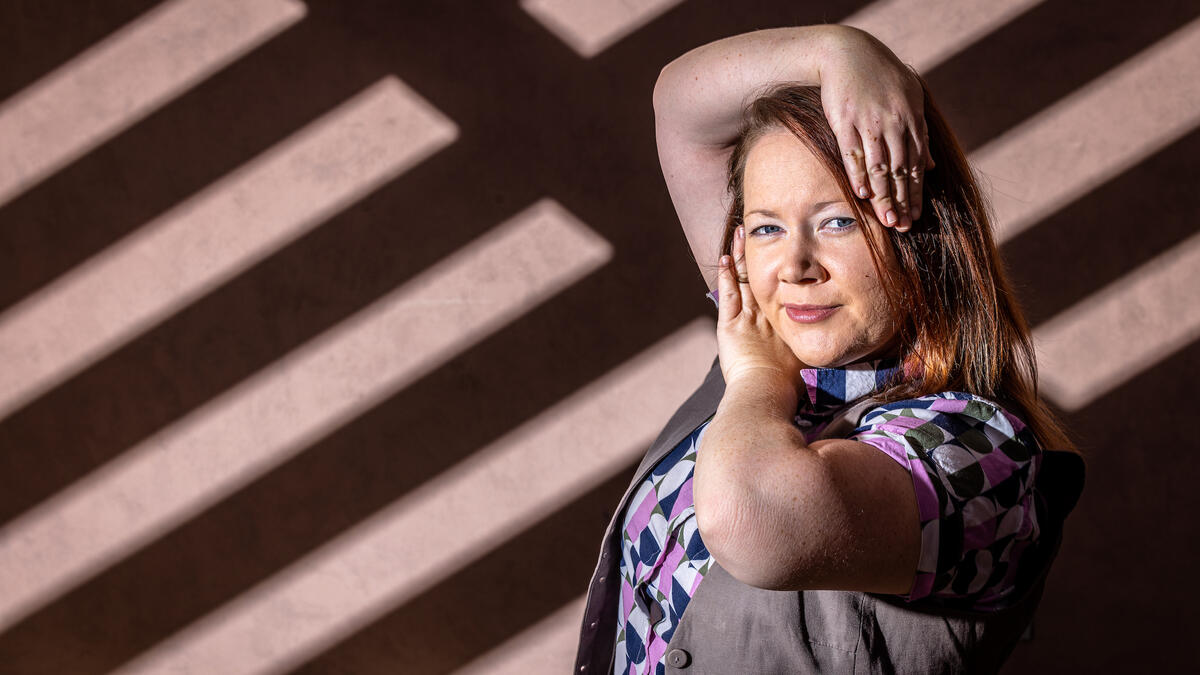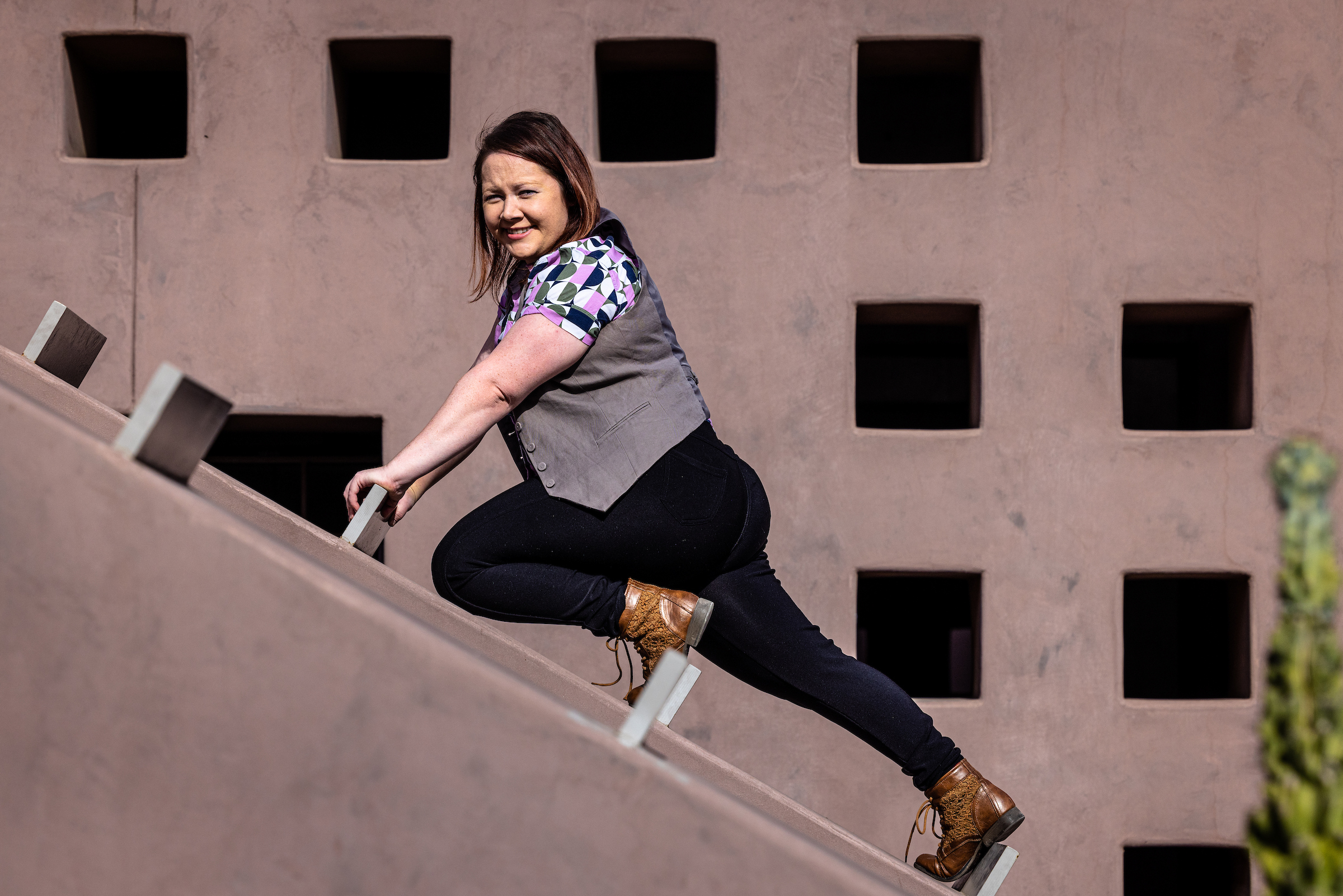Editor's note: This story is part of a series of profiles of notable fall 2021 graduates.
Ri Lindegren is graduating from Arizona State University with a degree in a unique area — dance and interdisciplinary digital media and performance.
Lindegren, who is earning a master’s degree in fine arts, is the Outstanding Graduate Student in the Herberger Institute for Design and the Arts this semester.
She calls her area of study “dance and technology” and describes it this way:
“Before I got into this program, I did a lot of dance videography. So I did a lot of dance on camera, or dance on film,” she said.
“Dance on camera is a very specific genre. The director is directing the gaze of the camera. It’s not just dance documentation.
“I applied to film schools and dance MFA programs, and I chose ASU because the School of Arts, Media and Engineering had more options for tech — tech I never heard of and was terrified of at the time.”
She took a lot of engineering classes.
“I did a smorgasbord of different technology to understand the field. My experience was exploring what the field of dance and technology could be and what it looks like now,” Lindegren said.
“I had a lot of supportive faculty in the dance department who said, ‘We don’t quite know what to do with you, so you can figure it out.’ And I appreciated that. I had a lot of freedom while still meeting the requirements.”
Lindegren has explored how to merge dance and technology in the context of body movement.
“If I want to project work onto a backdrop, I’m thinking about the movement that would work with that projection and how I can use technology to amplify what’s happening in the body.
“For me it’s been a lot about reclaiming technology and giving agency to the body, and to the dancer and to the human that’s in the space, rather than having the human adapt to the technology.”
Here, Lindegren talks about her time at ASU.
Question: Can you describe Body Sleuth, your virtual-adventure thesis project?
Answer: My research has been trying to find ways to remind us that we have bodies and reimagine how technology could be enhancing our quality of life in a different way, a holistic mind-body connection.
It’s like, “Look at this augmented reality app on my phone” or “Look at this cool new interactive game.” And you realize your body has hunched over and you have no awareness of it because you’re playing the game. Technology slowly starts to transform your body and how you’re experiencing yourself.
I was interested in creating an online community during the pandemic that brought people together, specifically by and for a queer community. Everyone who was a performer in the Body Sleuth project was LGBTQIAOften used to encompass the following identities: lesbian, gay, bisexual, transgender, queer/questioning, intersex and asexual/agender., and the people who played could be LGBTQIA or allies. It wasn’t trying to tokenize people or make them be out. It was an intentionally queer space, a space meant to uplift and support LGBTQIA people during the pandemic when a lot of people had to move back home, which might be an unsafe living environment.
They had avatars they could move around, and they interacted with different characters in this world that was totally fantasy. They met different characters that represented different levels of connecting to the body. It was all tied into movement in some way. They had a structured improvisation. It was very task oriented: “I have to walk across there in a robotic way or in a very free and fluid way or by rolling.”
They received boxes in the mail with tactile objects. During COVID, a lot of what I experienced was lack of touch and connection to people. There were little tiny skateboards and tufts of soft fabric that they had to create a scenario with. There was an instant soup packet, and we made soup together that they could eat at the same time over the camera to experience taste. It was giving a more expansive sensory experience to people behind the camera.
Q: What was your “aha” moment when you realized you wanted to study dance and technology?
A: My undergraduate degree was in anthropology, international studies and gender studies at New College of Florida in Sarasota. (The college) didn’t have a dance program, but I took a class every semester and I loved it. I decided I wanted to pursue dance even though I had not majored in it, so I needed a lot of training. I was going to all these dance intensives, one-week to five-week programs where you take three to five classes a day, every day.
I went to the Bates Dance Festival in Maine. They made this interactive space with all this tech in this large studio. They had projectors and cameras attached to projectors and lights and video, and you could remix the room however you wanted. We learned how to do videography and how to edit and the tech skills behind the work. All of a sudden it just clicked and made sense. I love to dance and I love some parts of technology, definitely video camera, and I love interdisciplinary work.
Q: What’s something you learned at ASU that changed your perspective?
A: For me, the biggest challenge was the technology hurdle, feeling like I wasn’t technologically savvy enough. There’s no class in the dance department that’s like, “Here, dancer, here’s how you learn the basic skills of computing or coding to get into this AME concentration.” I had to take the undergrad class as a grad student to get the basic skills to catch up. And the professors were so patient and supportive. It really helped build my confidence that I could learn these technological skills that I was very intimidated by. I learned how to solder wires together and look at JavaScript and code basic things. I still have a long learning curve ahead of me. But it gave me the confidence to pursue technology in a way I didn’t think I was capable of.
Q: Who were your faculty influencers?
A: I really appreciated Jessica Rajko, who’s an alum and was a professor here (who’s now at Wayne State University), and the work she was doing and how she talked about technology and dance. And Grisha Coleman mentored me here.
There’s a professor, David Olarte, and I’ve taken Afro-LatinxA gender-neutral term for Latino/a preferred by some individuals and groups. salsa with him and TA’d his class in "History of Afro-Latinx Salsa," and I love how he talks about the body as technology. There’s no computers or coding. I love the reframing of technology as the body.
I also loved Marcus White (who died in 2020), who was a mentor and my thesis adviser. The first class I ever took at ASU was his vogueing class, and I love vogueing. I’m not a member of the community and I don’t do vogue, but I appreciate it. And I’ll never forget that first class and I thought, “Oh cool! They have it all! They have vogueing, they have house dance, hip-hop, salsa, all of these options.”
Q: What are your plans after graduation?
A: I am passionate about social justice and making technology available to more people. Realistically it will probably be something related to media design or production consulting work.
Ri Lindegren, who is graduating with a master's degree in fine arts, outside the Nelson Fine Arts Center. Photo by Charlie Leight/ASU News
Q: What’s your favorite spot on campus? (Asked at the courtyard outside the Fine Arts Center.)
A: I love this place, and it has a lot of great memories. They always host what’s now called Sol Power and used to be called Urban Sol, and that’s one of my favorite events. I’ve done a lot of dance performances in this space. My other favorite spots are in (rooms) FAC 28 downstairs and FAC 122 that has this balcony where they do full-length shows because they have a light grid. Those are my favorite dance spaces. I love the Matthews Center for AME, which is a grad student space and we have our own desks and it has the iStage. And any spots with plants or nature.
Q: If someone gave you $40 million, what would you do?
A: My dream is to have my own multimedia production consulting company, so I’m able to network people together. I hear a lot from my artist friends about their dream visions, and now knowing what I know on the other side of it with tech, I’m like, "This is what you actually could do with that, and here’s a person you could talk to." It’s a matter of being like a translator between the two. It helps to have someone in the middle if you’re not from both worlds to help see the full possibility of what you could make.
So I would definitely start my own multimedia company that would include training and internship programs where people are paid to learn technological skills. I would do a lot of movement-oriented classes, as well as classes that support the mind-body connection. I have a very strong yoga practice, and I take it very seriously and I would love to do trauma-informed yoga and yoga that supports healing in different ways. There would be dance therapy and counseling that also connects people to technology and art and performance. And I would make sure a lot of the resources supported Indigenous communities, BIPOCBlack, Indigenous, people of color. communities, queer and marginalized communities, as well as creating accessibility for people with disabilities to come together.
Top photo: Ri Lindegren is the Outstanding Graduate Student in the Herberger Institute for Design and the Arts for fall 2021. Here she's in one of her favorite spots on the Tempe campus, the courtyard outside the Nelson Fine Arts Center. Photo by Charlie Leight/ASU News
More Science and technology

ASU-led space telescope is ready to fly
The Star Planet Activity Research CubeSat, or SPARCS, a small space telescope that will monitor the flares and sunspot activity of low-mass stars, has now passed its pre-shipment review by NASA.…

ASU at the heart of the state's revitalized microelectronics industry
A stronger local economy, more reliable technology, and a future where our computers and devices do the impossible: that’s the transformation ASU is driving through its microelectronics research…

Breakthrough copper alloy achieves unprecedented high-temperature performance
A team of researchers from Arizona State University, the U.S. Army Research Laboratory, Lehigh University and Louisiana State University has developed a groundbreaking high-temperature copper alloy…



